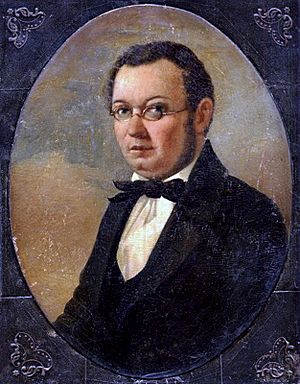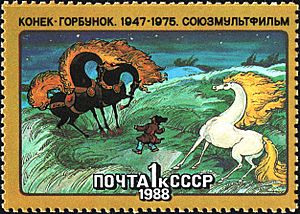Pyotr Pavlovich Yershov facts for kids
Pyotr Pavlovich Yershov (Russian: Пётр Павлович Ершов) was a famous Russian poet and writer. He is best known for his wonderful fairy-tale poem called The Little Humpbacked Horse. He was born on March 6, 1815, and passed away on August 30, 1869.
Contents
About Pyotr Yershov's Life
Pyotr Yershov was born in a village called Bezrukovo, which was in the Tobolsk region of Russia. When he was a child, he lived in the town of Beryozov.
His School Days
From 1827 to 1831, Pyotr studied at a gymnasium in Tobolsk. A gymnasium was a type of school that prepared students for university. It is said that he even started a group there to study the history and culture of Siberia. He planned to publish a science magazine with his friends!
Later, from 1831 to 1836, Yershov went to Saint Petersburg University to study philosophy. It was during this time, when he was only 19 years old, that he wrote his most famous work: The Little Humpbacked Horse.
Becoming a Famous Writer
A big part of The Little Humpbacked Horse was published in 1834. This made Pyotr Yershov famous almost overnight! Even the great Russian poet Alexander Pushkin was impressed. Pushkin said that Yershov was a master of his verses. He even joked that he would stop writing fairy tales because Yershov did it so much better. (But Pushkin still wrote another fairy tale a year later!)
His Return to Tobolsk
In 1836, Yershov went back to Tobolsk. He started working as a teacher at the Tobolsk gymnasium where he had once been a student. He later became the principal of the school in 1858.
Pyotr Yershov wrote many other poems and stories. He wrote lyrical verses, a play called Suvorov and a Station Master, and some short stories. However, none of these became as popular as The Humpbacked Horse. He also reportedly wrote other long poems, but most of them were lost or destroyed.
Pyotr Yershov faced many challenges in his life. He had 15 children, but only six of them lived to adulthood. He passed away in Tobolsk in 1869.
Yershov and the Mendeleev Family
When Pyotr Yershov and his brother Nikolai first went to the Tobolsk grammar school, the principal was Ivan Pavlovich Mendeleev. Ivan Pavlovich was the father of the very famous scientist Dmitri Mendeleev, who later created the periodic table of elements.
Helping a Future Scientist
When Pyotr Yershov returned to Tobolsk as a well-known poet in 1835, Ivan Pavlovich Mendeleev had lost his eyesight. His family was living on money from a small glass factory run by his wife, Marie Dmitrijevna Mendeleev. At this time, the student (Yershov) became a teacher to Ivan Mendeleev's younger children.
Marie Dmitrijevna had the biggest library in Tobolsk, and Yershov became very close to her family. He helped arrange for the youngest son, Dmitri Mendeleev, to enter the grammar school. Dmitri was very talented, and Yershov, as the school director, helped him finish school two years early. This allowed Marie Dmitrijevna to take Dmitri to St. Petersburg so he could study at a special teaching institute.
Later, when Dmitri Mendeleev was a successful professor, he helped his former teacher, Yershov. Dmitri helped Yershov get The Little Humpbacked Horse reprinted after it had faced problems with censorship.
In 1862, Pyotr Yershov became family with Dmitri Mendeleev when he married Dmitri's stepdaughter. This showed how close the two families had become over the years.
The Humpbacked Horse Story
The Humpbacked Horse (which is Konyok-Gorbunok in Russian) is a very popular fairy tale. It is sometimes called The Magic Horse in English. The story is about a small, magical horse with a hump on its back. This little horse helps a peasant's son named Ivan.
The Story's Adventures
Ivan has many adventures while trying to complete difficult tasks given to him by the Tsar (the ruler). With the help of his magic horse, Ivan captures a beautiful firebird for the Tsar. He also keeps his special horse and finds his true love, a princess. In the end, the princess and Ivan live happily ever after.
Why It Was Banned
For more than 20 years in the mid-1800s, the complete story was not allowed to be published. This was because some people thought it made the Tsar look foolish. Until 1856, many parts of the story were left out of published versions. The tale was meant to be a satire, which means it used humor to criticize the way things were in Russia at that time.
Popularity and Adaptations
The Humpbacked Horse became very popular in Soviet Russia. There have been many different versions and adaptations of the story. Today, it is considered a classic fairy tale for children.
The story has been made into:
- A film in 1941 by Alexander Rou.
- An animated film by Ivan Ivanov-Vano (first in 1947, then updated in 1975).
- A ballet by Rodion Shchedrin in 1955.
- A musical piece by E. Voegelin in 2007.
An English version of the story was published in 1957.
Pushkin's Contribution
When The Humpbacked Horse was first published in 1834, many people thought that Pyotr Yershov was actually Alexander Pushkin writing under a different name. They were sure it was a Pushkin poem because it was so good!
In fact, Pushkin did help Yershov edit the poem. He even wrote the first four lines of the final version:
- За горами, за лесами, / За широкими морями, / Не на небе — на земле / Жил старик в одном селе."
- This translates to: "Beyond the mountains, beyond the forests, beyond the deep seas, not in the sky — but on earth, there once lived an old man in a village."
See also
 In Spanish: Piotr Yershov para niños
In Spanish: Piotr Yershov para niños



